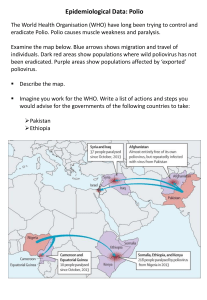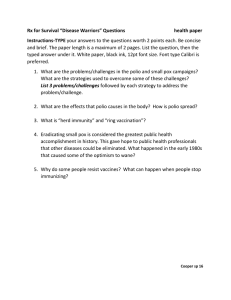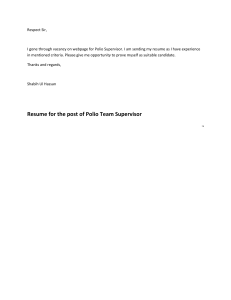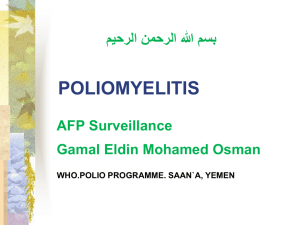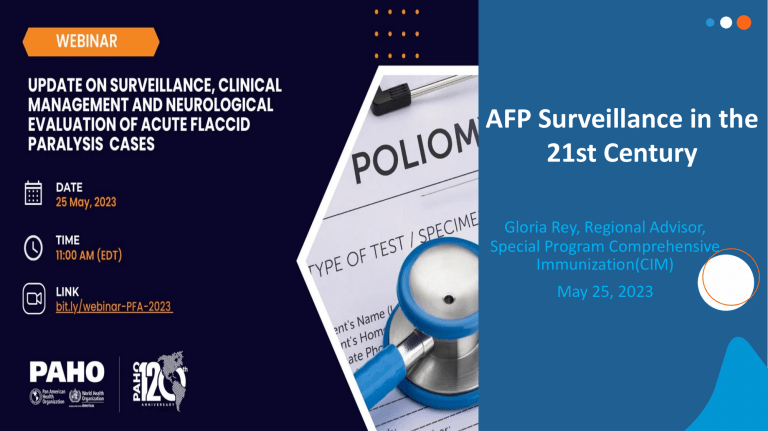
AFP Surveillance in the 21st Century Gloria Rey, Regional Advisor, Special Program Comprehensive Immunization(CIM) May 25, 2023 The virus and disease Progress on polio eradication Content Acute flaccid paralysis surveillance Polio situation in the Region of the Americas Polio Poliovirus Poliomyelitis (the agent) • • Poliovirus is an RNA virus, member of the genus Enterovirus, Picornaviridae family. There are three poliovirus serotypes (1, 2 and 3) with minimal immunity between them (heterotypic). • Poliovirus only infects people. • Person-to-person transmission: fecal - oral and pharyngeal secretions. (the disease) • Poliomyelitis is an infectious disease caused by the poliovirus. • The virus invades the nervous system and can cause permanent paralysis. • Most people infected (72%) have no symptoms. • One in 200 infections results in permanent paralysis and can cause death. https://www.paho.org/es/temas/poliomielitis https://www.cdc.gov/polio/what-is-polio/index.htm https://www.cdc.gov/polio/what-is-polio/hcp.html Poliomyelitis Wild poliovirus WPV Vaccine-derived poliovirus or VDPV*. Viruses originally present in nature. WPV2 and WPV3 have been eradicated. WPV1 is endemic in AFG and PAK. They are highly transmissible. In communities with low vaccination coverage, the virus mutates and recovers the neurovirulence => VDPV. There is a risk of transmission. Can be generated in immunodeficient individuals (PID). • • • Final classification of VDPV cVDPV circulating, evidence of H – H transmission. iVDPV associated with immunodeficiency. aVDPV ambiguous, the case is immunocompetent and the virus is not genetically related. mOPV Poliomyelitis vaccines OPV IPV • Licensed in 1963, created by Albert Sabin. • Introduced in 1955, created by Jonas Salk. • Live attenuated virus vaccine that may contain one, two or three serotypes. • Inactivated vaccine containing the three PV serotypes (1, 2 and 3). • It is administered orally. • Administered by intramuscular or intradermal injection (for fIPV). • Provides humoral immunity and long-term intestinal immunity; effective in stopping transmission. • In communities with low vaccination coverage, the virus can mutate and revert to neurovirulent (VDPV) and in rare cases, can cause vaccineassociated paralytic poliomyelitis (VAPP). • No risk of VAPP or VDPV. • Generates good humoral immunity but induces very low levels of antibodies in the intestinal mucosa. • Protects against paralytic disease but does not stop intestinal viral replication. Polio Eradication Eradication: permanent decrease to zero of the worldwide incidence of infection caused by a specific agent as a result of deliberate efforts. Last case of polio by WPV2 in 1999 Last case of polio by WPV3 in 2012 Declared eradicated in September 2015 Declared eradicated in October 2019 WPV1 & cVDPV1 polio cases, previous 12 months2 VIRUS COUNTRIES WPV1 3 21 cVDPV1 5 201 cVDPV2 19 475 CASES Endemic country (WPV1) 1Excludes viruses detected from environmental surveillance; 2Onset of paralysis: 24 May 2022 to 23 May 2023 Data in WHO HQ as of 23 May 2023 Milestones in the eradication of Polio in the Americas Outbreak of cVDPV1, 2000 2001 Polio cases, 1985 Certified polio-free 1994 Polio Surveillance Polio surveillance is conducted through the acute flaccid paralysis syndrome (AFP). Paralysis: weakness, loss or decrease of movement. Flaccid: loss of muscle tone. Acute: rapid progression of paralysis. All cases in children under 15 years of age presenting AFP for any reason except severe trauma, or any person of any age in whom poliomyelitis is suspected, should be investigated. The syndromic definition allows the surveillance system to be sensitive as it captures polio cases, but also other diseases present in similar ways. All cases should be thoroughly investigated including stool sample collection for laboratory diagnosis. Source: - Pan American Health Organization. Eradication of poliomyelitis: a practical guide. Third edition. 2005 Polio Global Eradication Initiative. Global guidelines for acute flaccis paralysis surveillance in the context of poliocirus eradication. Pre-publication version. Differential diagnoses of poliomyelitis There are many infectious and noninfectious diseases that can cause paralysis, and therefore be confused with poliomyelitis. Acute Flaccid Paralysis (AFP) Surveillance in the Americas 1995 2005 2023* Investigation of a suspected case of poliomyelitis Decision tree for case investigation Obtaining samples for laboratory diagnosis • Obtain a stool sample within 14 days of the onset of paralysis. • Use a clean, empty container to collect 8 g of stool (two-inch size). • Label all samples (case or contact name, case number, date of sample obtained). • Refrigerate samples immediately after collection (4 8 oC). • Rectal swab is a non-suitable sample. Packaging of biological samples Laboratory diagnosis of poliovirus 1 2 Virus Isolation in Cell Cultures Intratypic differentiation of poliovirus Timely reporting of results = 14 days Timely reporting of results = 7 days 3 Genetic sequencing of VP1 region Timely reporting of results = 7 days AFP Surveillance, case definitions 2 1 Probable case Any person under 15 years of age presenting AFP, for any reason except severe trauma, or any person of any age in whom poliomyelitis is suspected. 3 4 Confirmed case Compatible case Dismissed case Acute flaccid paralytic disease associated with isolation of wild poliovirus (or derived poliovirus VDPV), with or without residual paralysis. Acute paralytic disease with residual poliolike paralysis after 60 days, or failure to follow up or death, in which a stool sample was not obtained within 15 days of paralysis. Any case of acute paralytic disease for which an adequate stool sample has been obtained within 14 days of the onset of paralysis and with a negative laboratory result for poliovirus. AFP Surveillance Indicators Indicator System sensitivity Detection of at least 1 case of AFP/100,000 children under 15 years of age. Adequate investigation of the ≥80% of cases investigated (clinical, epidemiological) within 48 case hours of notification. Adequate stool sample ≥80% of cases had adequate stool samples collected for enterovirus detection (within 14 days of onset of paralysis) Case follow-up ≥80% of investigated AFP cases will be clinically evaluated within 60 days of onset of paralysis. AFP Surveillance Indicators, Region of the Americas 2019 – 2022* % casos PFA investigados <= 48 hs 100 86 86 85 2019 2020 2021 92 93 2022* Last 52w* 80 Tasa anual de casos de PFA 60 40 20 2.00 0 1.50 1.33 1.00 1.32 0.82 1.16 % casos PFA con muestra adecuada 0.93 0.50 0.00 2019 2020 2021 2022* Last 52w 100 90 80 70 60 50 40 30 20 10 0 73 74 70 77 77 2019 2020 2021 2022* Last 52w* Source: Country reports to PAHO. PAHO Polio Bulletin. Information as of May 6, 2023. Polio Cases in the Americas, 2022-2023 Case of cVDPV2 Polio in NY, USA - In an unimmunized immunocompetent young adult with no history of travel during the exposure period. - Provenance: Rockland County, NY State - Onset of paralysis: June 20, 2022 - Notification to PAHO/WHO: 21 July 2022 - Classification as cVDPV2: 10 Sept 2022 - GPLN confirmed genetic linkage of virus to cVDPV2 detected in UK and Israel. Case of polio due to VDPV1 in Loreto, PER - Male, 14 months old, with no history of vaccination or travel history. - Origin: Manseriche district, department of Loreto. - Onset of paralysis: December 29, 2022. - Stool sample collection: January 18, 2022 - VDPV1 confirmation: March 21, 2023 Investigation and clinical evaluation of the case ruled out primary immunodeficiency. Detection of cVDPV2 in wastewater, USA and Canada, 2022 Detection of PV2 in wastewater, NYS Source: https://health.ny.gov/diseases/communicable/polio/docs/waste_water_surveillance_report.pdf cVDPV2 in wastewater, Quebec, CAN - Notification to PAHO/WHO 06 Jan 2023, detection of VDPV2 in two samples collected in August 2022 - CDC confirmed genetic linkage to cVDPV2 case detected in Rockland, NYS - No confirmed cases of polio or increase in AFP cases have been observed in the province of Quebec. - Ambiguous, case is immunocompetent and the virus is not genetically related. No confirmed cases of poliomyelitis or an increase in AFP cases have been observed in the province of Quebec in 2022. Source: Canada IHR National Focal Point Polio Bulletin Polio Bulletin https://www.paho.org/es/boletin-semanalpolio GTA Recommendations 1. Countries should make an effort to improve the performance of AFP surveillance indicators to avoid undiagnosed cases of paralysis caused by poliovirus. 2. Countries with a very high risk of outbreaks should consider collecting a second stool sample on a temporary basis while they strengthen their immunization program and surveillance system. 3. If a stool sample cannot be collected from the AFP case within 14 days of the onset of paralysis, or if the sample arrives at the laboratory in poor condition, it is recommended that a sample from three contacts be collected. XXVI Meeting of PAHO’s Technical Advisory Group (TAG) on Vaccine-Preventable Diseases. Vaccines bring us closer, 14-16 July 2021 (virtual). Full report available at: https://iris.paho.org/handle/10665.2/54833 IX Ad Hoc Meeting of the PAHO Technical Advisory Group (TAG) on Vaccine-Preventable Diseases, 25 July 2022 (Virtual). Full report available at: https://iris.paho.org/handle/10665.2/56566 The commitment to keep the region polio-freeResolution CSP30.R13, September 2022 Develop and implement a prioritized and targeted mitigation plan based on the recommendations of the GTA and the RCC. • Increase vaccination coverage • Improve surveillance • Ensure adequate preparedness for outbreak response Engage civil society, community leaders, NGOs, private sector, academia and other stakeholders to move forward and work in a joint and coordinated manner. Acknowledgment To all health professionals in the s countries of the Region who have collaborated with polio program activities. To the Ministries of Health for maintaining their commitment to the polio program and sharing information with PAHO/WHO. To the CAN and the NCCs for their ongoing support and recommendations to keep the Region polio-free.
